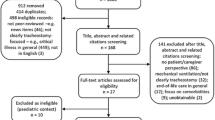Abstract
To establish the effect of tracheostomy on nasal function and quality of life. Teaching Hospital, Scotland, UK. Cross-sectional case–control study. Two groups of patients were selected; a group of ten patients who underwent surgical tracheostomy and a control group of ten patients with confirmed or suspected head and neck malignancy that did not require tracheostomy. Two questionnaires, the SNOT-22 quality of life instrument, and the Rhinogram nasal symptoms score were used to evaluate each group. For the Rhinogram questionnaire the median total score was 13.5 for the tracheostomy group and 2 for the control group (P = 0.02) whilst for the SNOT-22, the mean total scores were 39 and 29, respectively (P = 0.205). The tracheostomy group scored worse for all Rhinogram questions, and for the anosmia score this was independently statistically significant (5 vs. 0 units, P = 0.001). The tracheostomy group most commonly identified “loss of smell & taste” as their most important symptom, compared with only 2 subjects in the control group. Tracheostomy can give rise to nasal symptoms. This needs to be addressed in the routine follow up of these patients.
Similar content being viewed by others
References
Tos M, Mogensen C (1979) Experimental surgery on the nose. Changes of the epithelium in the vestibular region at altered airflow. Acta Otolaryngol 87:317–323
Cvetnic V, Batistic B, Sankovic F (1987) Cytological & histological alterations in the nasal mucous membrane during experimental obstruction of nasal openings. Rhinology 25:5–12
Shin SH, Heo WW (2005) Effects of unilateral naris closure on the nasal & maxillary sinus mucosa in the rabbit. Auris Nasus Larynx 32:139–143
Boyce J, Eccles R (2006) Do chronic changes in nasal airflow have any physiological effect on the nose and paranasal sinuses? A systematic review. Clin Otolaryngol 31:15–19
Hilgers FJM, Van Dam FSAM, Keyzers S, Koster MN, Van As CJ, Muller MJ (2000) Rehabilitation of olfaction after laryngectomy by means of a nasal airflow inducing maneuver. The “polite yawning” technique. Arch Otolaryngol Head Neck Surg 126:726–732
Magardino TM, Suskind-Liu D, Kroger H, Mirza N (2001) Ipratroprium nasal spray for the treatment of rhinorrhea in the laryngectomized patient: a pilot study. Am J Rhinol 15:203–206
McNeill EJM, Samuel PR (2005) Nasal polyposis in the laryngectomee. JLO 119:57–58
Maurizi M, Paludetti G, Almadori G, Ottaviani F, Todisco T (1986) Mucociliary clearance and mucosal surface characteristics before and after total laryngectomy. Acta Otolaryngol 102:136–145
Cvetnic V, Sips D (1988) Clinical and cytological alterations in nasal mucosa in laryngectomized patients. Rhinology 26:183–190
Fisher EW, Lund VJ, Rutman A (1992) The human nasal mucosa after deprivation of the airflow. A study of laryngectomy patients. Rhinology 30:5–10
Ozdem C, Ercan MT (1984) Measurement of blood flow to human nasal mucosa in normal and pathological conditions by the use of the 133Xe clearance technique. Arch Otorhinolaryngol 239:219–227
Bende M (1983) Blood flow in human nasal mucosa after laryngectomy. Acta Otolaryngol (Stockh) 96:529–531
Toppozada HH, Gaafar HA (1976) Human nasal blood vessels after permanent tracheostomy electron-microscopic study. ORL J Otorhinolaryngol Relat Spec 38:35–44
Havas TE, Cole P, Gullane P, Kassel R (1987) Alterations in nasal physiology. The nasal cycle. J Otolaryngol 16:149–153
Fisher EW, Lui M, Lund VJ (1994) The nasal cycle after deprivation of airflow. A study of laryngectomy patients. Acta Otolaryngol (Stockh) 114:443–446
Morley AD, Sharp HR (2006) A review of sinonasal outcome scoring systems-which is best? Clin Otolaryngol 31:103–109
Hopkins C (2009) Patient reported outcome measures in Rhinology. Rhinology 47:10–17
Piccirillo J, Merritt M, Richards M (2002) Psychometric and clinimetric validity of the 20-item sino-nasal outcome test (SNOT 20). Otolaryngol Head Neck Surg 126:41–47
Piccirillo JF, Edwards D, Haiduk A (1995) Psychometric and clinimetric validity of the 31-item Rhinosinusitis outcome test (RSOM-31). Am J Rhinol 9:297–306
Buckland JR, Thomas S, Harries PG (2003) Can the sino-nasal outcome test (SNOT 22) be used as a reliable outcome measure for successful septal surgery? Clin Otolaryngol 28:43–47
Browne JP, Hopkins C, Slack R et al (2006) Health-related quality of life after polypectomy with and without additional surgery. Laryngoscope 116:297–302
Srouji IA, Andrews P, Edwards C, Lund VJ (2006) General and rhinosinusitis-related quality of life in patients with wegener’s granulomatosis. Laryngoscope 116:1621–1625
Van Oene CM, Van Reij E, Sprangers M, Fokkens WJ (2007) Quality assessment of disease specific quality of life questionnaires for rhinitis and rhinosinusitis. A systematic review. Allergy 62:1359–1371
Hopkins C, Gillett S, Slack R, Lund VJ, Browne JP (2009) Psychometric validity of the 22-item sinonasal outcome test. Clin Otolaryngol 34:447–454
Lund VJ, Kennedy DW (1995) Staging and therapy group. Quantification for staging sinusitis. Ann Otol Rhinol Laryngol 167:17–21
Fairley JW, Durham LH, Ell SR (1993) Correlation of subjective sensation of nasal patency with nasal inspiratory peak flow rate. Clin Otolaryngol 18:19–22
White P (2004) Subjective scoring systems in Rhinology. ENT News 12:50–51
Patel PM, Maskell S, Heywood R, Eze N, Hern J (2010) Prospective, comparative, cohort study comparing the rhinogram, sino-nasal outcome test 20 and health-related quality of life questionnaire. JLO 124:623–630
Conflict of interest
None.
Author information
Authors and Affiliations
Corresponding author
Rights and permissions
About this article
Cite this article
Tsikoudas, A., Barnes, M.L. & White, P. The impact of tracheostomy on the nose. Eur Arch Otorhinolaryngol 268, 1005–1008 (2011). https://doi.org/10.1007/s00405-011-1522-1
Received:
Accepted:
Published:
Issue Date:
DOI: https://doi.org/10.1007/s00405-011-1522-1




